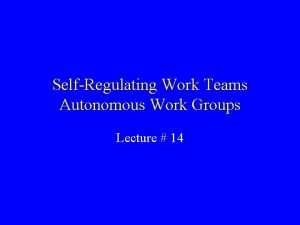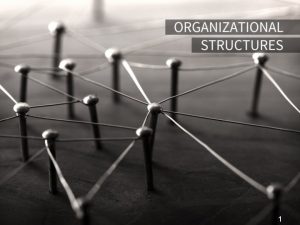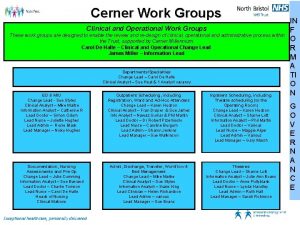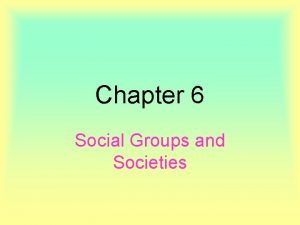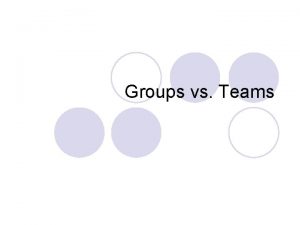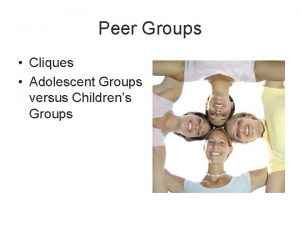Chapter 13 Ending the Groups Work Slides developed




















- Slides: 20

Chapter 13 Ending the Group’s Work Slides developed by Ronald W. Toseland State University of New York at Albany An Introduction to Group Work Practice, 7 e Toseland Rivas © 2011 Pearson Education, Inc. All Rights Reserved

Factors that Influence Group Endings • Open and closed membership policy • The cohesion of the group • Whether the group is a treatment of task group • Educational and socialization groups versus other forms of treatment groups An Introduction to Group Work Practice, 7 e Toseland Rivas © 2011 Pearson Education, Inc. All Rights Reserved

Planned and Unplanned Termination • Member termination – Early terminations versus later terminations – Fewer terminations in group than individual work • Group cohesion and not wanting to let down other group members An Introduction to Group Work Practice, 7 e Toseland Rivas © 2011 Pearson Education, Inc. All Rights Reserved

Factors Leading to Termination • External factors such as scheduling conflicts • Group deviancy such as being the only member with an uncontrolled psychoses • Problems in developing intimate relationships • Fear of emotional contagion An Introduction to Group Work Practice, 7 e Toseland Rivas © 2011 Pearson Education, Inc. All Rights Reserved

Factors Leading to Termination • Inability to share the workers’ time • Complications arising from concurrent individual and group therapy • Early deep self-disclosures • Severe acting-out behaviors • Inadequate orientation to therapy • Complications arising from strong subgroups An Introduction to Group Work Practice, 7 e Toseland Rivas © 2011 Pearson Education, Inc. All Rights Reserved

Worker Termination • Steps to Reduce Disruption – Members should be told as early as possible when termination will occur – The reasons for termination should be shared with the group; encouraged to discuss their feelings – Unfinished business should be completed if possible An Introduction to Group Work Practice, 7 e Toseland Rivas © 2011 Pearson Education, Inc. All Rights Reserved

Ending Group Meetings • Keep members focused on the topic of discussion • Limit the time that each member has to discuss an issue • Summarize what has been said • Obtain closure on each issue as it is discussed • Do not bring up new items An Introduction to Group Work Practice, 7 e Toseland Rivas © 2011 Pearson Education, Inc. All Rights Reserved

Ending the Group as a Whole • Learning from group members • Maintaining and generalizing changes • Reducing group attraction and promoting independent functioning • Help members deal with feelings about ending • Planning for the future • Making referrals An Introduction to Group Work Practice, 7 e Toseland Rivas © 2011 Pearson Education, Inc. All Rights Reserved

Maintaining and Generalizing Changes • Helping members work on relevant situations • Help members develop confidence in their abilities • Using a variety of different situations and settings to help members learn new behaviors • Using a variety of naturally occurring consequences An Introduction to Group Work Practice, 7 e Toseland Rivas © 2011 Pearson Education, Inc. All Rights Reserved

Maintaining and Generalizing Changes • Extending treatment through follow-up sessions • Preventing setbacks by practicing difficult situations and how to overcome obstacles • Helping members to solve problems independently; problem solving framework An Introduction to Group Work Practice, 7 e Toseland Rivas © 2011 Pearson Education, Inc. All Rights Reserved

Program Activities for Ending • Demonstrate and encourage reflection about skills members have learned in the group • Encourage members to express their feelings about the group and each other • Focus on future activities • Encourage activities outside the group • Write letters to self encouraging change An Introduction to Group Work Practice, 7 e Toseland Rivas © 2011 Pearson Education, Inc. All Rights Reserved

Positive Feelings about Endings • Feelings of empowerment and potency – Members realize they are capable of accomplishing their goals • A feeling of independence resulting from greater control of their lives An Introduction to Group Work Practice, 7 e Toseland Rivas © 2011 Pearson Education, Inc. All Rights Reserved

Positive Feelings about Endings • A sense of satisfaction and pride in successfully completing the group experience • A feeling of usefulness from helping others • A feeling of confidence and resiliency that problems can be coped with and solved An Introduction to Group Work Practice, 7 e Toseland Rivas © 2011 Pearson Education, Inc. All Rights Reserved

Negative Feelings About Termination • Denial that the group will end or not wanting it to end • Feelings of disappointment, powerlessness, abandonment or rejection • Acting out • Anger or hostility • Devaluing the group experience An Introduction to Group Work Practice, 7 e Toseland Rivas © 2011 Pearson Education, Inc. All Rights Reserved

Worker Reactions to Termination • Pride and accomplishment in the client’s success • Pride in therapeutic skills • A renewed sense of therapeutic process • Sadness, sense of loss, or ambivalence about no longer working with the client An Introduction to Group Work Practice, 7 e Toseland Rivas © 2011 Pearson Education, Inc. All Rights Reserved

Worker Reactions to Termination • Doubt or disappointment about the members’ progress or ability to function independently • A re-experiencing of workers’ own losses • Relief, doubt or guilt about their effectiveness as a helper An Introduction to Group Work Practice, 7 e Toseland Rivas © 2011 Pearson Education, Inc. All Rights Reserved

Planning for the Future • Contracting for new short-term groups • Transitioning to another level of care • Members asking to meet on their own – does not often continue for long without a leader • Self-help referrals • Tapping support systems and resources • Using booster sessions An Introduction to Group Work Practice, 7 e Toseland Rivas © 2011 Pearson Education, Inc. All Rights Reserved

Referral Principles • Call the contact person while the member is with the leader • Emphasize that the member is expected at the referral source • Provide instructions for getting to the referral source An Introduction to Group Work Practice, 7 e Toseland Rivas © 2011 Pearson Education, Inc. All Rights Reserved

Referral Principles • Assist with transportation if necessary • Ensure that disabilities do not prevent a successful referral • Ensure the member reached the referral source and received the needed services An Introduction to Group Work Practice, 7 e Toseland Rivas © 2011 Pearson Education, Inc. All Rights Reserved

Failure of Referrals • The referral source has had a change in policy or no longer has the service • The member – Lacks motivation or desire – Lacks the skill necessary to obtain needed services – Has been given incorrect information/not enough help by the worker to reach the referral source An Introduction to Group Work Practice, 7 e Toseland Rivas © 2011 Pearson Education, Inc. All Rights Reserved
 A small child slides down the four frictionless slides
A small child slides down the four frictionless slides A crane lowers a girder into place
A crane lowers a girder into place How are ethnic groups and religious groups related
How are ethnic groups and religious groups related Chapter 9 section 1 the nature of interest groups
Chapter 9 section 1 the nature of interest groups Unplanned termination of members from a group
Unplanned termination of members from a group Autonomous work groups
Autonomous work groups Workgroups are characterized by
Workgroups are characterized by Models of social group work slideshare
Models of social group work slideshare Understanding groups and managing work teams
Understanding groups and managing work teams Structures are laid-back and undefined.
Structures are laid-back and undefined. Making small groups work
Making small groups work Chapter 4 work and energy section 1 work and machines
Chapter 4 work and energy section 1 work and machines Hình ảnh bộ gõ cơ thể búng tay
Hình ảnh bộ gõ cơ thể búng tay Bổ thể
Bổ thể Tỉ lệ cơ thể trẻ em
Tỉ lệ cơ thể trẻ em Voi kéo gỗ như thế nào
Voi kéo gỗ như thế nào Tư thế worm breton
Tư thế worm breton Chúa sống lại
Chúa sống lại Các môn thể thao bắt đầu bằng từ đua
Các môn thể thao bắt đầu bằng từ đua Thế nào là hệ số cao nhất
Thế nào là hệ số cao nhất





